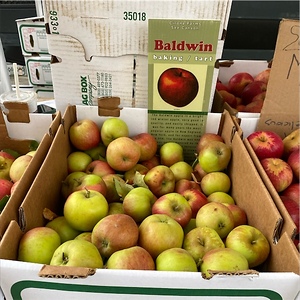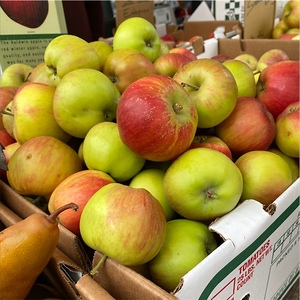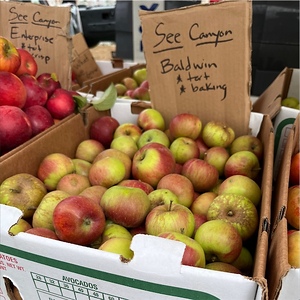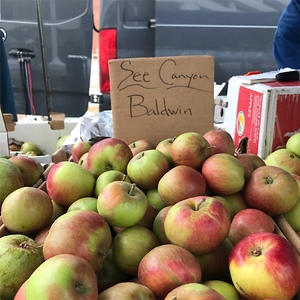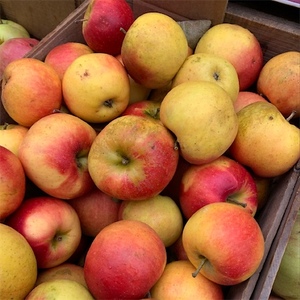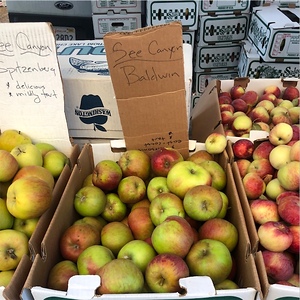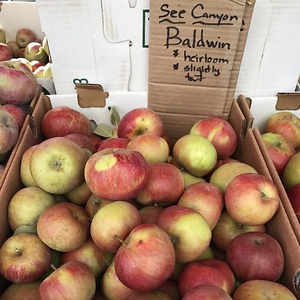


Baldwin Apples
Estimated Inventory, lb : 0
Description/Taste
Baldwin apples are a medium to large varietal, averaging 6 to 8 centimeters in diameter, and have a round to conical, slightly lopsided shape. The apple’s skin is thick, developing a tough and chewy consistency, and has a matte appearance with some russet and yellow lenticels. The skin also has a yellow-green base and is covered in a vibrant red-orange blush with striping. Underneath the surface, the white to ivory, green-tinged flesh is coarse, aqueous, and dense with a crisp and firm texture. The flesh also contains a small central core filled with tiny black-brown seeds. Baldwin apples have high acidity and sugar, contributing to the fruit’s sweet-tart flavor, followed by warm, fruity, and aromatic spice-filled nuances.
Seasons/Availability
Baldwin apples are available in the fall through winter.
Current Facts
Baldwin apples, botanically classified as Malus domestica, are a mid to late-season variety belonging to the Rosaceae family. The heirloom apples are one of the oldest varieties in New England and were discovered growing as a chance seedling in the late 18th century in an orchard in Massachusetts. Baldwin apples were a popular commercial and home garden cultivar throughout the 19th and early 20th centuries, valued for the apple’s sweet-tart flavor and dense, crisp nature. The fruits were regarded as a dual-purpose cultivar, used in fresh and cooked preparations, and the apples were also traditionally pressed into ciders. Baldwin apples are known by several names, including Woodpecker, Pecker, Butter’s Woodpecker apple, Steele’s Red Winter, Calville Butter, Butter’s apple, Felch apples, and Red Baldwin’s apples. These descriptors were given to the variety over time as the apples changed ownership and were marketed under different farmers in the early stages of commercial introduction. Growers favored Baldwin apples for their prolific nature, thick skin, and extended storage capabilities, allowing the fruits to be shipped overseas to Europe without exterior damage. In the modern-day, Baldwin apples have become a rare variety, overshadowed by other commercial cultivars, but the apples have retained a small following in the northeastern United States, grown as a boutique variety through specialty and private orchards.
Nutritional Value
Baldwin apples are a good source of fiber to regulate the digestive tract, potassium to balance fluid levels within the body, and vitamin C to strengthen the immune system. The apples also contain calcium, phosphorus, and boron to build strong bones, vitamin E to protect the cells against free radical damage, vitamin A to maintain healthy organ functioning, and lower amounts of zinc, iron, copper, and magnesium.
Applications
Baldwin apples are a multi-purpose variety with a sweet-tart flavor suited for fresh and cooked preparations. The apples have tough, chewy skin, and when consumed fresh, the skin can be peeled or left intact, depending on preference. Baldwin apples can also be sliced and dipped into caramel, chocolate, and nut butter, layered into sandwiches and placed on toast, chopped into salads, slaws, and fruit bowls, or quartered and displayed on cheese plates. The apples can also be used as a fresh topping over breakfast dishes such as oatmeal, waffles, and pancakes, mixed into grain bowls, or blended into smoothies. In addition to fresh preparations, Baldwin apples are known for their sweet-tart juice and have been frequently used in cider blends in the United States for over two hundred years. The apples contain a high sugar content, and when the flesh is fermented, the sugar ferments into approximately 6% alcohol with citrusy and melon-like undertones. Baldwin apples also hold their shape well when cooked and are often mixed with tarter apple varieties to create a layered flavor profile in baked goods such as pies, tarts, muffins, crisps, and cobblers. The apples develop a caramelized, sweet taste when sauteed with butter and spices, can be cooked down into a puree and sauce for roasted meats, or can be hollowed and baked as a healthy dessert. Baldwin apples pair well with dried fruits such as cranberries, raisins, figs, and cherries, spices including cinnamon, cloves, ginger, and nutmeg, vanilla, and nuts such as walnuts, pecans, pistachios, and almonds. Whole, unwashed Baldwin apples will keep 1 to 4 months when stored in the refrigerator's crisper drawer or cold storage.
Ethnic/Cultural Info
In Wilmington, Massachusetts, a monument marks the site of the first Baldwin apple tree. The monument was constructed in 1895 by the Rumford Historical Association of Woburn and is comprised of a five-foot stone pedestal with a carving of a Baldwin apple on top of the rectangular base. There is also an inscription that recounts the history of the apple, and the original inscription credited surveyor Samuel Thompson with the discovery of the apple. It took over 60 years to edit the inscription, changing the text to include the origins of the variety’s name, given in honor of Colonel Loammi Baldwin. In the modern-day, the Baldwin Apple Monument is one of the few monuments in existence dedicated to a specific apple variety. In Woburn, Massachusetts, a statue erected of Colonel Loammi Baldwin features a plaque at the base, which mentions Baldwin’s famous role in promoting Baldwin apples. This statue is about two miles north of the Baldwin Apple Monument and is significant as Baldwin was a prominent historical figure of the 19th century. Beyond apples, Colonel Loammi Baldwin was a well-known Revolutionary War veteran who crossed the Delaware River with George Washington and fought in the battles of Lexington and Concord. After the war, Baldwin requested cuttings from the Baldwin apple tree and cultivated his own personal tree. The war veteran was also the first Superintendent of the famous Middlesex Canal.
Geography/History
Baldwin apples were discovered growing as a chance seedling in Wilmington, Massachusetts, in the orchard of John Ball in 1740. The apple’s parentage is unknown, and the variety remained localized to Ball’s farm for approximately 40 years. Ball’s farm was eventually sold to William Butter, who named the cultivar Woodpecker apples as the tree attracted many woodpeckers. Butter transplanted the apple tree from the orchard to a site closer to his house and began commercially selling the variety sometime around 1784. During this time, residents also nicknamed the fruit Butter’s apples in honor of William Butter. In the late 18th century, Deacon Samuel Thompson was surveying land to construct the Middlesex Canal and encountered the Baldwin apple tree. He told Colonel Loammi Baldwin, a famous figure of England, about the apple variety, and Baldwin went in search of the sweet-tart fruits. Colonel Loammi Baldwin highly favored the apple and widely contributed to its commercial fame during the late 19th century, leading growers and distributors to rename the variety in honor of Baldwin. Baldwin apples were among the most popular apples in the northwestern United States in the late 19th and early 20th centuries, but in 1934, a winter freeze decimated over two-thirds of the Baldwin trees in New England. The variety was replaced commercially by mcintosh apples and never fully recovered as growers decided not to replant the cultivar due to its biennial nature. Today Baldwin apples are found in limited quantities through specialty growers, private orchards, and home gardeners in the northeastern and Midwest United States. The cultivar was also planted in England and is grown as a boutique variety in select orchards. When in season, Baldwin apples are found through local growers, farm stands, markets, and specialty distributors.
Recipe Ideas
Recipes that include Baldwin Apples. One
| New England Apples |
|
Apple Mini Pies |
| The Kitchn |
|
Butternut Squash, Apple and Sage Soup |



